Notes
Our Gang
Yesterday, I saw an image from Iraq that really struck me.
It was a stencil — almost like a gang insignia — on the wall of a petrol station that had just been raided by U.S. soldiers. The symbol was a skull with the the number “24” inscribed in it.
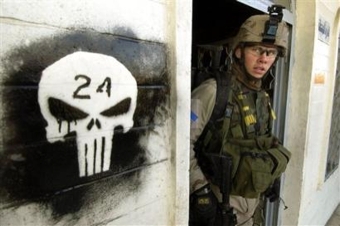
Having looked at a good number of newswire photographs, I’ve started to recognize the work of particular photographers and even some outfits in which they’ve been embedded. In this case, I won’t mention the infantry unit that conducted this raid, but the caption identified it as having a “24” in it.
One thing I’ve been grappling with lately is how young American (and British) soldiers could have come to abuse Iraqi prisoners. Yesterday, I happened to hear Seymour Hirsch on the radio. He thinks it’s ridiculous the military is blaming prisoner abuse on “a couple bad apples.” Hirsh described our troops as mostly young and naive. He explained that many are from small, out of the way places, or from guard units with virtually no training in handling suspects, let alone prisoners. He felt the military was denying its natural “in loco parentis” responsibility — providing for its soldiers in a similar way a university provides for the guidance and supervision of its students.
Not having a military background, I can’t functionally explain this skull symbol. It could have a completely practical purpose, perhaps signifying the building has been inspected for weapons. Even if it’s functional, though, I can’t help but believe it has a dual role. Graffiti, as I understand it, typically involves the marking of territory by groups or individuals who feel dispossessed. If this is even partially the case here, then my question is: What instinct would cause this unit to leave its signature (such a macabre one, by the way) on this building? What does it say about the mind of the “24” that they would want to mark (you could also say, deface) property they are charged with protecting?
Because I knew the designation of the regiment, and because I was curious, I decided to search for more images of this unit. I found out that these guys are stationed in an extremely volatile Iraqi city, and have been tasked — for the last month, at least — to search homes, businesses and buildings for insurgents and weapons.
If you’ve been following this blog, you know I’ve done a few (somewhat controversial) posts about the imposition of U.S. troops into “the Iraqi domestic space.” Maybe the overlap was inevitable, but I discovered I had even shown this unit in one of my write-ups (See: — Someone’s Been Sitting in my Chair …and They’ve Broken it all to Pieces!. It’s the shot where the soldier is coming through the door and the little boy is in back past the green curtain.)
Looking at a few weeks of images from this regiment didn’t lessen my skepticism about its mission, but it gave me much greater sympathy for the young men carrying it out. The degree of anxiety and unpredictability, and the level of constant suspicion directed toward mostly innocent people, is almost beyond comprehension.
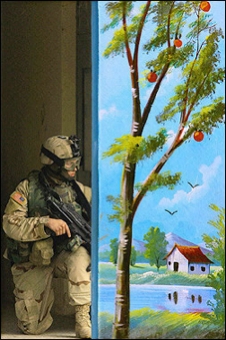
Here, one of the soldiers has to guard for attack at the same time a “public affairs mission” is taking place at a primary school.
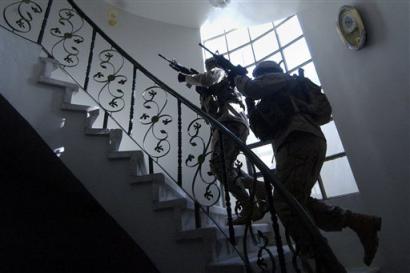
Here, a couple of men are having to storm someone’s house.
Not that far removed from wearing the yellow hat, these guys have got to feel like intruders and ghosts at the same time.
The farthest back I was able to go with the images was about a month. Toward the end, I came upon another shot that jumped out at me. Besides capturing the incredible stress of actually finding and disposing of weapons, this picture seemed to also say something about the desperate attempt to have the last word in a dialogue of insanity.
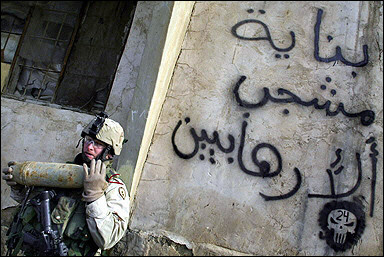
Again, the skull might have a totally practical function. I look at that tag, however, and it also says a number of other things. It says we are marked men surrounded by darkness. It says how angry we are. It says were are no longer names, but a number. It says we are the deliverers of death, and also its recipient.
To me, the symbol also makes prisoner abuse a little more comprehensible. If this Pentagon is going to drop young people into hell with not enough tether, I can see how — after a certain amount of time — those kids might want somebody to pay for it.
(image 1: AP Photo/Jim MacMillan; image 2: AFP/Mauricio Lima: image 3: AP Photo/Jim MacMillan; image 4: AP Photo/Jim MacMillan; image 5: AFP/Mauricio Lima. All images via YahooNews.)
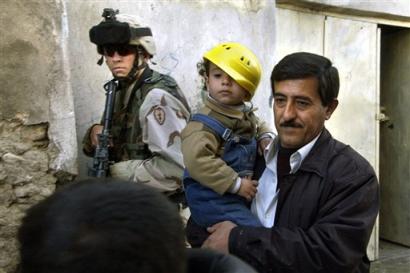

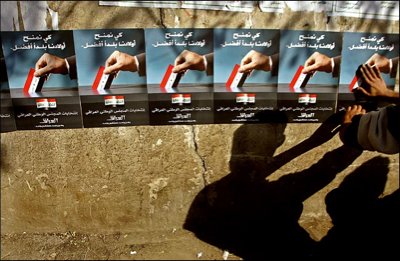
Reactions
Comments Powered by Disqus